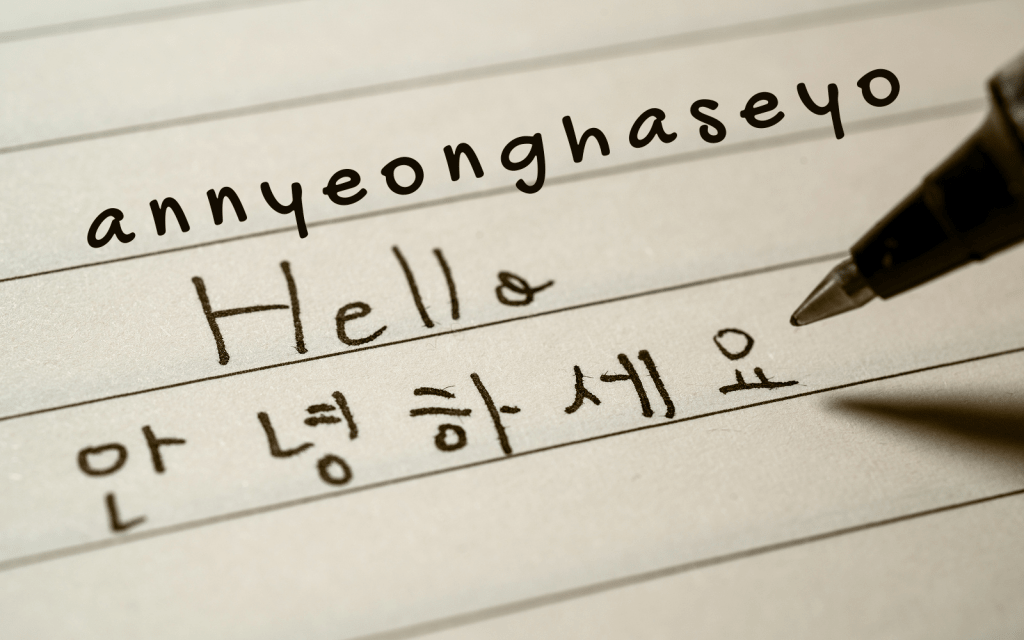In learning the Korean language, specifically the Korean alphabet, Korean romanization comes in handy. In this article, we will give you a brief and compact overview of romanization. This will help you understand how to use it best. Let’s get to learning!
Here’s a downloadable version of this article that you can bring anywhere:
Contents
- 1 What is Korean romanization?
- 2 Which Korean romanization system should be used?
- 3 Hangul Romanization Chart
- 4 Using romanization to spell a Korean word with English letters
- 5 Helpful resources for learning Korean words with Hangul romanization
- 6 Hangul Romanization Converter
- 7 Korean romanization vs. pronunciation
- 8 Problems with romanization
- 9 Tools for Romanization of Korean
- 10 Easy romanization rules
- 11 Conclusion
What is Korean romanization?
Romanization means writing Korean words using Roman letters or the Latin alphabet instead of Hangul, the Korean alphabet. This is used to make the texts easier to read for people who don’t know Korean.
Romanization includes rules that can be applied to transcription, which involves converting audio/sound to text, and transliteration, which converts text from one language to another while keeping the same pronunciation.
Should I learn Korean with romanization?
Learning Korean with romanization is okay if you only want to learn a few Korean words. Using romanization to read and understand words in Korean is helpful if you don’t know the Hangul alphabet yet.
However, we recommend learning the Korean alphabet thoroughly as soon as possible, as it’s more accurate for learning the proper sounds. It only takes about 1 hour, and it will help tremendously with standard Korean pronunciation. You won’t be able to get very far in learning Korean using romanization only.
Just keep in mind that romanized Korean is meant to aid you in your early Korean language learning but will eventually hamper how you study Korean if you become dependent on it.
Why should people learn romanization of Korean?
Romanization is a tool often used in the early stages of learning languages. Although you shouldn’t be dependent on it throughout your Korean learning journey, it has some advantages. Here are some of them:
To help people who can’t read Korean (Hangul)
Korean can be understood easily without the knowledge of Hangeul by people who can’t read it. For example, if you meet someone at a restaurant in Korea, you may want to write the restaurant name in both Hangeul and romanized English so it can be located easily.
Typing on a computer or smartphone
Some computers or smartphones may not have 한글 (Hangeul) installed. Romanization may be helpful to still get your message across without having to type it in Hangeul.
Which Korean romanization system should be used?
There are multiple romanization systems used in Korea, which may at first look confusing to you as the same Hangul letter might have several romanizations. However, in this article, we are sticking to the Revised Romanization of Korean. It is also the system used on our site and in all our materials.
Revised Romanization of Korean
The Revised Romanization of Korean, or RR for short, is seen as the most common and most accepted system for the romanization of the Korean language today. This has been used in South Korea since 2000. Therefore, you cannot go wrong by using this system.
One significant feature of the Revised Romanization system is that it tries to match the spelling of each word as closely as possible to how they’d look if they were an English word. This is done to enforce a foreign language speaker’s ability to pronounce Korean naturally.
McCune–Reischauer Romanization
Another romanization system is the McCune–Reischauer Romanization, also known as MR. There are South Korean and North Korean variants of this romanization system. It remains to be the official romanization system in North Korea. However, this romanization system was replaced when the RR was established in South Korea in 2000.
Hangul Romanization Chart
We have listed the Hangul alphabet and its romanized Korean version that follows the RR Korean system. This will serve as a guide as you start reading the Korean alphabet and eventually Korean words, phrases, and sentences.
Korean Consonants (RR System)
Below are the Korean consonants written in Hangul and their romanization using the RR system.
| Hangul | Romanization |
|---|---|
| ㄱ | g/k |
| ㄲ | kk |
| ㅋ | k |
| ㄴ | n |
| ㄷ | d/t |
| ㄸ | tt |
| ㅌ | t |
| ㅁ | m |
| ㅂ | b/p |
| ㅃ | pp |
| ㅍ | p |
| ㄹ | r/l |
| ㅅ | s |
| ㅆ | ss |
| ㅈ | j |
| ㅉ | jj |
| ㅊ | ch |
| ㅎ | h |
| ㅇ | silent / ng |
Korean Vowels (RR System)
Listed below are Korean vowels and their romanized version.
| Hangul | Romanization |
|---|---|
| ㅏ | a |
| ㅓ | eo |
| ㅗ | o |
| ㅜ | u |
| ㅡ | eu |
| ㅣ | i |
| ㅐ | ae |
| ㅔ | e |
| ㅑ | ya |
| ㅕ | yeo |
| ㅛ | yo |
| ㅠ | yu |
| ㅒ | yae |
| ㅖ | ye |
| ㅘ | wa |
| ㅚ | oe |
| ㅙ | wae |
| ㅝ | wo |
| ㅟ | wi |
| ㅞ | we |
| ㅢ | ui* |
*although it is romanized as such, the pronunciation of this one can change a lot depending on where in the word or sentence it is placed.
Using romanization to spell a Korean word with English letters
Now that we have learned the romanization of each Korean letter, let’s learn how to spell a word in the Korean language using English letters. Let’s take the word 밥. To romanize it, follow the chart above.
ㅂ = b (first)
ㅏ = a
ㅂ = p (last).
As a result, the Korean romanization of 밥 is “bap.” Romanization of Korean is pretty straightforward, and you can start by practicing with shorter words like 밥 to longer ones.
Helpful resources for learning Korean words with Hangul romanization
We have several articles that you can read to familiarize yourself better with romanization and different vocabulary in Korean at the same time. Here are some of them:
- Korean Nouns
- Food in Korean
- Fruits, Nuts, and Vegetables in Korean
- Jobs in Korean
- Colors in Korean
- Flowers in Korean
- School in Korean
- Animals in Korean
- Korean Nature
- Korean Furniture
- Business in Korean
- Cook in Korean
- Hobbies in Korean
Hangul Romanization Converter
Below are two Korean romanization converter tools we recommend if you’d like to convert Hangul characters to their romanized versions. For example, if you type in the Korean word 집, it will be converted to “jip.”
These are great aids that you can use while you are still familiarizing the Korean alphabet.
Korean Romanization Converter
Website: http://roman.cs.pusan.ac.kr/input_eng.aspx?
This tool for romanizing Korean words using the Roman alphabet provides you with three options and displays several results.
It’s convenient because there are several romanization alternatives based on your needs. However, if you’re using this for different words, you must repeatedly hit the “back” button to obtain the English spelling of a new Korean word.
The Hangul Romanizer
Website: http://www.codywatts.com/romanizer/
Using the Korean system’s Revised Romanization, this romanizing tool may quickly romanize Korean words. It’s useful since you don’t have to type “enter”; simply write or paste the Korean word, and the romanization will appear immediately.
The disadvantages are that you may have to wait for the website to load, and the site is occasionally unavailable. It’s possible that the romanization is inaccurate. Therefore, it’s still best to double-check the findings.
Korean romanization vs. pronunciation
Keep in mind that the first/last letters are for romanization and not necessarily for pronunciation.
We recommend using the “b” sound for ㅂ when saying the word 밥. If you are spelling the word 밥, you’re normally going to use Hangeul and spell it 밥. If you need to spell it in English, you can spell it as “bap.”
RR largely follows the same rules as Korean pronunciation, in general. For example, there are changes in romanization when certain Korean letters meet each other. These are the special pronunciation rules. To learn more about how Korean pronunciation works, read our article on Korean pronunciation!
Problems with romanization
Romanization is generally beneficial; however, there might be some problems that you will encounter as you use it. We’ve enumerated a few of them:
Not everyone uses the same romanization system
As we have covered above, there are different romanization systems used in South Korea. This means that people may have different preferences when it comes to the romanization system that they will use, which can confuse some.
For example, you may see the romanization for the word 언니 (sister) spelled as unnie. The correct way to romanize it is eonni. However, that spelling is not as common as unnie—the same with hyung vs. hyeong for 형 (brother).
You can’t make the proper Korean alphabet sounds using English
Reading some Korean words can be tricky when you use romanization. Take the word 의사 (doctor), for example. The romanization is uisa, but that doesn’t accurately show the correct pronunciation. If you don’t know Hangul, you’re likely to mispronounce it.
Tools for Romanization of Korean
Pusan University has an excellent romanization tool. If you want some tools to help with romanization, we also have an article in Korean Romanization Dictionary that may interest you.
Easy romanization rules
Vowels typically follow a singular way of romanization as well as pronunciation. The exception to this is the vowel combination ㅢ.
Consonants can have different romanizations based on where they are in the syllable. Some examples are ㄱ, ㅂ, and ㄷ.
A great rule of thumb is that a softer romanization should be used when this consonant is before a vowel. Meaning, ㄱ is g, ㅂ is b, and ㄷ is d. And when another consonant follows the word’s end, the harder romanization letter is used. Note, though, that for ㄹ, r is used if it’s placed before a vowel. If it’s at a word’s end or before a consonant, it should be l.
Conclusion
Romanization can be really helpful in learning Korean as you start. But if you want to take your Korean learning to the next level, you can go for our structured online courses. You should be able to read Korean without relying on romanizations anymore. If you like the sound of it, know more about the courses here.
We’d also love to read your comments on how easy or difficult you find using romanization while learning Korean. So please do drop us a comment or a few in the comment box below!








How can I learn Korean language
Thanks for the comment, Lisa. ^^ If you want to learn Korean, we have a step-by-step resource guide called Learn Korean Online: How-To Guide for Language Study that you can follow. You can also check our blog and visit our YouTube channel for articles and videos with great Korean content.
I really enjoy learning Korean, it’s really helpful. Thanks.
I’m still trying to understand and memorize the Korean vowels in Hangul and Romanization.
That’s great! It’s our pleasure. We’re glad that it has been valuable to you. ^^
Very helpful, thanks
Sure, it’s our pleasure. We’re glad that it has been valuable to you. ^^
This is really helpful for beginners.
That’s great! We’re glad that it has been valuable to you. ^^